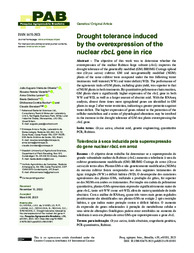Drought tolerance induced by the overexpression of the nuclear rbcL gene in rice.
Drought tolerance induced by the overexpression of the nuclear rbcL gene in rice.
Author(s): OLIVEIRA, J. A. V. de; VIANELLO, R. P.; LANNA, A. C.; DEDICOVA, B.; ROCHA, D. C.; BRONDANI, C.
Summary: The objective of this work was to determine whether the overexpression of the nuclear Rubisco large subunit (rbcL) improves the drought tolerance of the genetically modified (GM) BRSMG Curinga upland rice (Oryza sativa) cultivar. GM and non-genetically modified (NGM) plants of the same cultivar were compared under the two following water treatments: well watered (WW) and water deficit (WD). The performance of the agronomic traits of GM plants, including grain yield, was superior to that of NGM plants in both treatments. By quantitative polymerase chain reaction, GM plants show a significantly higher expression of the rbcL gene in both WW and WD, as well as a larger amount of abscisic acid. With the RNAseq analysis, almost three times more upregulated genes are identified in GM plants in stage 2 after water restriction, indicating a greater protection against water deficit. The higher expression of genes related to the protection of the cellular metabolism and a series of physiological alterations may be involved in the increase in the drought tolerance of GM rice plants overexpressing the rbcL gene.
Publication year: 2023
Types of publication: Journal article
Unit: Embrapa Rice & Beans
Observation
Some of Embrapa's publications are published as ePub files. To read them, use or download one of the following free software options to your computer or mobile device. Android: Google Play Books; IOS: iBooks; Windows and Linux: Calibre.
Access other publications
Access the Agricultural Research Database (BDPA) to consult Embrapa's full library collection and records.
Visit Embrapa Bookstore to purchase books and other publications sold by Embrapa.

